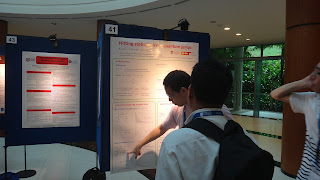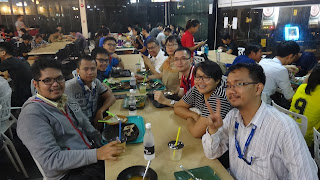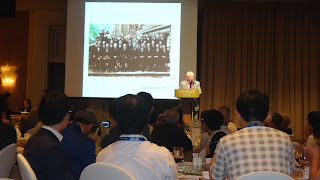First, one might ask why the 90 years? In the past, we have even heard of 100 years of Planck's Quantum which takes 1900 as the year where Planck forwarded the idea of quanta of radiation. Quantum mechanics in its modern setting took form when Heisenberg proposed matrix mechanics in 1925. The more intuitive Schrodinger wave mechanics came slightly later, published in 1926. As the form of quantum mechanics took shape, there was this famous Solvay Conference in 1927 that had all the pioneers of quantum theory in one single conference. It is said that the NTU conference took this conference as the marked event and hence the 90 years.
The conference had an impressive list of speakers including Nobel prize winners and very distinguished researchers (I was told that they had an international committee that vet through the suggested list). It kicked start with a recorded address from Nobel Laureate C.N. Yang, followed by a talk by another Nobel Laureate Gerard 't Hooft entitled "How Quantum Mechanics Modifies the Space-Time of a Black Hole". When it comes to quantum foundations, 't Hooft ideas are considered unconventional. He has proposed (super) deterministic models of quantum mechanics for many years now and one can find his views in a published book "The Cellular Automaton Interpretation of Quantum Mechanics" and as an arXiv article here. Determinism has become a dirty word in quantum community and thus one finds debates when ideas like this gets proposed. Frankfully, I'm sympathetic to his idea as much as I am to some ideas from Spekkens model, and I hope to read his book sometime in the future. He also speaks about his recent ideas of black hole antipodal entanglement and virtual black holes in the talk.
The other talk that captured my attention that morning was Jim Hartle's "Quantum Mechanics in the Light of Cosmology" in which he pays tribute to Nobel Laureate Murray Gell-Mann who coauthored with him in a paper of the same title. He highlighted the fact that cosmology involves retrodiction and that fashions the quantum formalism in this case. A relatively more recent update of his views is available here.
Later in the afternoon, another Nobel Laureate, David Gross gave his talk. The title was unknown until he put up his slides - Quantum Mechanics and its Discontents. In a way, his talk seems to assert the fact that quantum mechanics has been very successful and it is difficult to change the theory (and he mentioned Weinberg's attempts see e.g. here). However he did mentioned the areas (mainly gravitational) for which quantum mechanics needs to be reexamined and in particular the area of theories without Lagrangian, alluding to M-theory I guess. His views can be read here (not all discussed there).
The poster session was at the end of the first day and Kwek rather in an impromptu asked me to be one of the judges. I told him that my students are also putting up posters but he said it was ok (guess being professionalis expected). Looked more on content first and its clarity, then the poster display. During the poster session also, my students got to meet David Gross. Here are some pics then.
That night, despite the drizzle (heavy at times), we went for dinner at a nearby canteen. Also with us, is Dr. Clarissa Lee from UKM.
The second day include again many luminaries that I know from my student past and present day, Thibault Damour, Alexander Vilenkin, Lars Brink, Hermann Nicolai and Nobel Laureate Tony Leggett which is recorded earlier. Leggett's lecture was interesting as he spoke on the several tests of macroscopic realism. Since the talk was not live, there are some things that weren't clear (at least to me) particularly on quantum counterfactualities. Anyway, here is a link of slides that could help. He also mentioned the following two experiments that deserve to be read later:
Hermann Nicolai's talk also captured my attention. It was on "Quantum Gravity and Unification". Before my PhD, I followed developments in supergravity and unification theories, but left these to pursue my PhD interests. Then, it was known then that N=8 supergravity might not be finite and many left the area for superstring theory which is gaining popularity. But through his talk, there is now renewed interest in N=8 supergravity based on E_10 symmetry. This was not considered before, being infinite-dimensional and we were told that it includes N=8 supergravity and as bonus may include family symmetries and dualities. One can read the development (minus family symmetry) in these slides. Worth to renew interest here.
Perhaps the most surprising lecture that day (and I suppose the whole conference) was the one from Matthew Fisher (son of Michael Fisher). It was sneakily titled "Are We Quantum Computers, or Merely Clever Robots?". Not knowing him and the development in this area, I could easily pass it as crank-ish. But Fisher build his case cleverly and entertainingly. A problem with making biological matter (like the brain) to be a quantum processing machine is that it is expected that the thermal environment might wash-out all the quantum effects. Apparently there are still loopholes that can be considered, namely phosphate nuclear spins exhibited by Posner molecules which are somewhat protected. It would be interesting to see where this leads to (even if the brain is not a quantum computer).
The second night was the conference dinner and we sat almost together as a group (Dr Chan, Choong and Ganesh at a different table) with another Philippines participant, Marvin Flores. Here are some pics.
The last two pictures are after dinner with Prof. Kwek and Prof. Martial Auguste Adonis Ducloy (past president of European Physical Society, now visiting NTU).
The third day had Boris Altshuler, Shoucheng Zhang, Hideo Ohno, Peter Zoller, Ignacio Cirac and Immanuel Bloch. The ones that captured my attention are the ones by Zoller and Cirac. Zoller's talk was more surprising since I did not know the developments they made with atom trap quantum computing for which he mentioned the possibility to do lattice gauge theories. This will lead to the interplay between three areas of quantum information, high energy physics and many-body physics. Cirac talks about tensor networks and the possible demonstration of holographic paradigm for graph states; again suggesting interplay of quantum information, many body physics and high energy physics. The third night had barbecue dinner, for which I did not go since I was coughing badly and needed a rest.
Thursday was the last day of the conference with chemists opening up the morning session which includes Nobel Laureate Rudolph Marcus. Others for the day was Arieh Warshel, Per Delsing, Jiangfeng Du, Miles Padgett, Sixia Yu, Jun Ye and William Munro. Padgett's talk on quantum ghost imaging got my attention for the day (see here). The conference ends with a panel discussion on the future of quantum science & technology. It was chaired by Da Hsuan Feng and the panel members are Boris Altshuler, Viatcheslav Mukhanov, Jun Ye and Peter Zoller.
Late night, we had an informal discussion with Prof. Kwek on many matters.
Our other group photos:
I have to thank the IAS, Prof. K.K. Phua, Prof. Kwek and Mr. Raymond for making our trip possible. We look forward to the suggested conference of 100 Years of Quantum Mechanics ( Iw ill be retired then).
































No comments:
Post a Comment